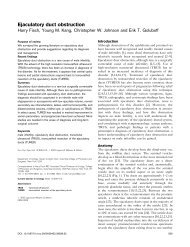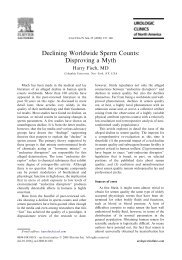Vasectomy Success Presentation - Dr. Harry Fisch
Vasectomy Success Presentation - Dr. Harry Fisch
Vasectomy Success Presentation - Dr. Harry Fisch
Create successful ePaper yourself
Turn your PDF publications into a flip-book with our unique Google optimized e-Paper software.
Defining the<br />
Standard for<br />
<strong>Vasectomy</strong><br />
<strong>Success</strong><br />
<strong>Harry</strong> <strong>Fisch</strong> MD<br />
Professor of Clinical Urology<br />
Columbia University
Controversies Regarding g <strong>Vasectomy</strong><br />
Management<br />
1. Is vasectomy a permanent form of birth control?<br />
2. When do we obtain a post-vasectomy semen analysis?<br />
3. What is the significance of motile and non-motile sperm<br />
in the post-vasectomy semen analysis?<br />
4. Does azoospermia after vasectomy guarantee that<br />
sperm will not reappear?<br />
5. Do we need to centrifuge azoospermic semen after<br />
vasectomy in order to detect occasional sperm?
1. Is vasectomy a permanent<br />
form of birth control?
<strong>Vasectomy</strong> is Not Guaranteed<br />
<strong>Vasectomy</strong> pregnancy failure rate of 0.1%<br />
‣ Early-unprotected intercourse prior to obtaining a<br />
negative semen analysis<br />
‣ Late-recanalization of the vas deferens<br />
Tubal ligation pregnancy failure rate of 1.85%<br />
Trussell J et al, Contraceptive Technology 1998<br />
Peterson HB et al, NEJM 1997<br />
Weiske, Andrologia 2001<br />
Schwingl and Guess, Fert and Steril 2000
2. When do we obtain a post-<br />
vasectomy semen analysis?
ANALYSIS OF SPERM CLEARANCE<br />
Time to azoospermia<br />
100%<br />
90%<br />
80%<br />
70%<br />
60%<br />
50%<br />
Finger 1997 , Cortes 1997, Arango 1993, De Kniff 1997, O’Brien 1995, Badrakumar 2000<br />
Mason 2002, Smith 1998, Hancock 2002, Alderman 1989, Barone 2003, Nazerali 2002
“Clinical aspects of vasectomies performed<br />
in the United States in 1995”<br />
Most physicians requested the first semen analysis too soon!<br />
• < 6 weeks - 59%<br />
• 7-9 weeks - 29%<br />
• > 9 weeks - 12%<br />
Haws et al, Urology 1998<br />
Only ¾ of men are azoospermic at 3 months
Different methods of vasal occlusion<br />
have similar sperm clearance rates<br />
• Fascial interposition<br />
does not reduce time to<br />
azoospermia<br />
• No association between<br />
length of excised vas<br />
and time to azoospermia<br />
Clenney. Amer Fam Phy. 1999 Bennett. Urology. 1976. Schmidt. Urol Clin N Amer. 1987.<br />
Haws. Urology. 1998 Esho. J Urol. 1978. Labrecque. Fert Ster. 2003.
3. What is the significance of motile<br />
and non-motile sperm in the post<br />
vasectomy semen analysis?
Significance of Motile Sperm<br />
• Motile sperm caused by:<br />
‣Technical error<br />
‣Recanalization between the two ends of the<br />
vas deferens<br />
• Motile sperm 3-6 months after vasectomy<br />
is more likely to be associated with<br />
pregnancy<br />
(Edwards, d Fert. Steril 1993)
Significance of Non-motile Sperm<br />
• Non-motile sperm caused by :<br />
‣ release of nonviable residual sperm in the distal<br />
reproductive tract 1<br />
‣ recanalization between the two ends of the vas<br />
deferens 2<br />
• Risk of pregnancy from non-motile sperm is<br />
similar to the risk of pregnancy after two<br />
azoospermic semen analyses (0.05%) 3<br />
1 De Knijff et al , Fert Steril 1997<br />
2 Goldstein et al, J Urology 1996<br />
3 Haldar, Lancet 2000 & Benger et al, BJU 1995
4. Does azoospermia after vasectomy<br />
guarantee that sperm will never<br />
reappear in the future?
Reappearance of Occasional<br />
Sperm After Azoospermia<br />
• O’Brien et al BJU 1995<br />
0.6% (1 year)<br />
• Labrecque et al CAF 1998<br />
q 2.2% (< 1year)<br />
• DeKnijff et al Fert Steril 1997<br />
8.0% (2 years)<br />
• Goldstein et al J Urology 1996<br />
97%(10 9.7% years)<br />
• Freund and Couture J Androl 1982 100% (2-31 years) *<br />
* “Presence of a small number of spermatoza in vasectomized men<br />
is a normal and usual sequela of vasectomy”
5. Do we need to centrifuge a post-<br />
vasectomy azoospermic semen<br />
specimen in order to detect rare<br />
sperm?
Centrifugation of azoospermic semen<br />
• Recommended by laboratory guidelines<br />
WHO and ASCP<br />
• It is not the current clinical standard of<br />
care for vasectomy
Conclusion<br />
• Sterility post-vasectomy is not guaranteed<br />
• Post-vasectomy semen analysis recommended at<br />
3 to 6 months<br />
• Post-vasectomy semen analysis should<br />
demonstrate azoospermia or non-motile sperm<br />
before contraception is discontinued<br />
• Sperm may reappear despite initial azoospermia<br />
• Centrifugation of azoospermic semen in order to<br />
detect rare sperm is not the clinical standard of<br />
care
Informed consent should indicate the<br />
requirement of a post-vasectomy semen<br />
analysis and the potential failure rate<br />
associated with vasectomy




